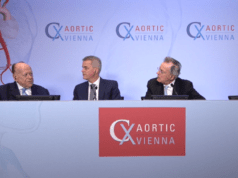
Opening the session on iliac arteries and the five-branch technique for type I endoleaks, Christopher Neumayer (Vienna, Austria) argued that the superficial femoral vein should be used for reconstruction in septic aortic surgery.
“Aortic infections have a high incidence of about 5%,” Neumayer began, adding that they are associated with a mortality of up to 30% in the first year and more than 70% in the long run. There was consensus among the panellists for his conclusion that, so long as the aorta is not too big, “deep veins are a good option for reconstruction of the aortoiliac axis in patients with severe infections”.
Ian Loftus (London, UK) postulated that the threshold for iliac aneurysms should be set at 4cm. He noted that while current guidelines recommend treatment of iliac aneurysms >3.5cm, the evidence base for this is “very poor”. Loftus concluded: “Most surgeons already feel it is safe to monitor iliac aneurysms until they are >4cm and the natural history data we have, albeit of very poor quality, support this programme of conservative management”. However, “we clearly do need better data,” he added, detailing that international registries should pool data to better guide practice.
Next to speak was Lorenzo Gibello (Turin, Italy), who discussed results of different stent grafts used in conjunction with iliac branch devices in endovascular aortoiliac aneurysm repair, concluding that “balloon-expandable and self-expanding stent grafts performed similarly when used as mating components of iliac branch devices”.

Considering aortoiliac preservation using endovascular techniques in aneurysmal disease, Jan Heyligers (Tilburg, The Netherlands) told registrants that iliac branch technology is a “feasible technique” and offers endovascular specialists a “solid tool to preserve the hypogastric flow with good clinical results”. Heyligers concluded: “When technically feasible, a bilateral preservation of the internal iliac arteries should be considered and can be performed safely”.
Fadi Taher (Vienna, Austria), who is a member of moderator Afshin Assadian’s group in Vienna, presented early multicentre results on a fenestrated iliac device in the treatment of complex aortic pathologies. “The device may be a valuable tool in patients unsuitable for treatment using iliac branch devices,” Taher concluded, adding that preservation of internal iliac artery blood flow can avoid complications, such as buttock claudication or even potentially debilitating sequalae such as bowel or spinal cord ischaemia. As this is a custom-made device, Taher ended with a note that there is a waiting period, and its use at the moment is therefore reserved for the elective setting. In the discussion following Taher’s presentation, Assadian expressed how proud he was of Taher.
Closing the session, Piotr Kasprzak (Regensburg, Germany) spoke on the five-branch technique for type I endoleak after endovascular aneurysm repair (EVAR), concluding that it is a useful technical option for this purpose, especially patients with a short infrarenal space.
This session, and all other sessions from day three of CX Aortic Vienna, is available to view on demand. Click here to register and access the recording.













